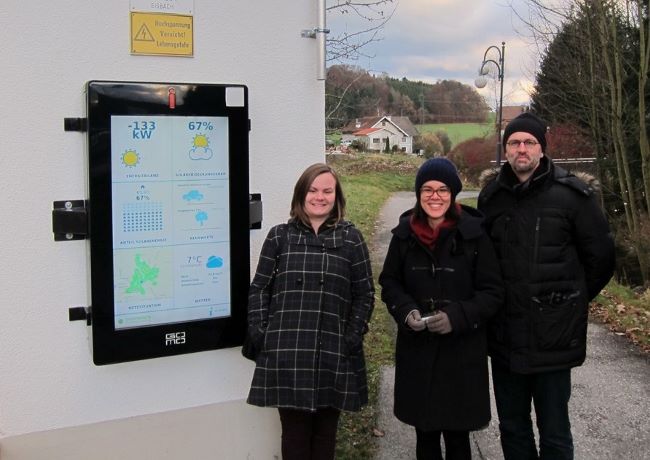In November 2016, Michael Ornetzeder, Tanja Sinozic and Alicia Gutting from the Institute of Technology Assessment (ITA), Austrian Academy of Sciences, made a visit to the village of Köstendorf, 25 km outside of the city of Salzburg. The pilot project in Köstendorf is part of the Smart Grids Model Region Salzburg government programme, which encompasses a broad range of smart grid pilot and demonstration projects focusing on technology conceptualisation, testing and production. The federal state of Salzburg has the ambition to become climate-neutral, energy-autonomous and sustainable by 2050. This means, that not only the electrical energy, but all primary energy sources have to be entirely climate-neutral.
Since 1985, the small rural village Köstendorf, which has about 2500 inhabitants, has been engaged in various energy projects and is also an active member in an energy municipality network.
Our first stop in Salzburg was at the local energy provider Salzburg AG, where Markus Radauer, the coordinator of the smart grids field test in Köstendorf, welcomed us. He gave us a short introductory presentation on the smart grids operations of the Salzburg AG in general and about the activities in Köstendorf in particular. The background of the smart grids research projects in Salzburg is the importance of prescient planning and calculation. Grid investments usually have a durability of about 40 years, so the status quo or the status in the next five years is not very important for today’s grids calculation. The utility has to be prepared and should know what will be going on within the next 20 to 30 years. Therefore, research on renewables is a major operational field and strategies and long-term scenarios have to be drawn up today. If grid operators miscalculate the need of new grids, they will be facing high expenses in future, which, in the end, will be transferred to the customer.
The objective of the project in Köstendorf is the integration of small households and EVs into the local smart grid. The implemented solution is a microgrid with rooftop photovoltaics, smart meters, ICT infrastructure and EVs. 90 buildings take part in the field test with 43 PV systems with about 192 kWp in total.
Following the introductory presentation to the project, we drove with a company-owned electric vehicle to Köstendorf. The village tour started at one of the central participating households with a PV system as well as a battery and two EVs. Mr Radauer explained how the PV system and the battery are controlled and how intelligent charging works in this case. An interesting point was that the implemented configuration is not optimal from an economic point of view; neither for the Salzburg AG nor for the customer. This means, the participants are ecologically motivated and dependent upon financial subsidies to making a difference in times of climate change. There is also an energy nature trail (Energieweg) in Köstendorf about “smart grids of the future”, which explains the significance of smart grids for the energy transition and attracts many “energy tourists” throughout the year who are interested in seeing how the local system works.

The research team from ITA visiting Köstendorf. Photo: Michael Ornetzeder.
At the end of the tour, we got to see the adjustable local grid transformer, which is one of the central elements of the microgrid that manages to feed surplus solar energy back into the higher level grid. Our field trip was full of new impressions and it was very important to us to actually get to see the technology at work. Now we can set the information, we gathered through the interviews, into context and start working on our case studies.
/ Alicia Gutting
